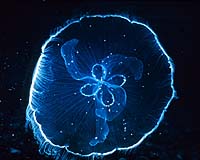| . |  |
. |
Chicago IL (SPX) Jul 30, 2009 In the Late Paleozoic (260 million years ago), long before dinosaurs dominated the Earth, ancient precursors to mammals took to the trees to feed on leaves and live high above predators that prowled the land, Jorg Frobisch, PhD, a Field Museum paleontologist has concluded. Elongated fingers, an opposable "thumb," and a grasping tail of Suminia getmanovi demonstrate that this small plant-eating synapsid is the earliest known tree-climbing vertebrate. Suminia was relatively small, about 20 inches from its nose to the tip of its tail. The tree-climbing lifestyle of this Paleozoic relative of mammals is particularly important because for the first time in vertebrate evolution it gives access to new food resources high off the ground, and also provides protection from ground-dwelling predators. The evidence for this lifestyle is based on several excellent skulls and more than a dozen exceptionally well preserved, complete skeletons from a single large block of red mudstone that was discovered in central Russia's Kirov region. Having so many individual specimens, some of mature individuals and some of youngsters, was helpful in providing a complete picture of the animal's skeletal anatomy, said Frobisch. "It's relatively rare to find several animals locked on a single block," he said. "We have examples of virtually every bone in their bodies." Finding that vertebrates took to trees so early in Earth's evolution was unexpected. "It's a surprise, but it makes sense," Frobisch said. "It was a new niche for vertebrates. There was food available and they avoided predators on the ground." The study also provides the first evidence in the fossil record of food partitioning between small climbing and large ground-dwelling plant-eaters and this happens shortly after the establishment of the modern terrestrial ecosystem with large numbers of plant-eaters supporting few top predators. Earlier terrestrial vertebrate communities did not have this modern hierarchy, but instead were composed of various-sized predators and relatively few plant-eaters, with most of the food resources being provided by insects and aquatic organisms. Share This Article With Planet Earth
Related Links Field Museum Darwin Today At TerraDaily.com
 150 years later, Darwin vindicated... by jellyfish
150 years later, Darwin vindicated... by jellyfishParis (AFP) July 29, 2009 Creatures large and small may play an important role in the stirring of ocean waters, according to a study released Wednesday that confirms a theory advanced by Charles Darwin. So-called ocean mixing entails the transfer of cold and warm waters between the equator and poles, as well as between the icy, nutrient-rich depths and the Sun-soaked top layer. It plays a crucial part in marine biodi ... read more |
|
| The content herein, unless otherwise known to be public domain, are Copyright 1995-2009 - SpaceDaily. AFP and UPI Wire Stories are copyright Agence France-Presse and United Press International. ESA Portal Reports are copyright European Space Agency. All NASA sourced material is public domain. Additional copyrights may apply in whole or part to other bona fide parties. Advertising does not imply endorsement,agreement or approval of any opinions, statements or information provided by SpaceDaily on any Web page published or hosted by SpaceDaily. Privacy Statement |